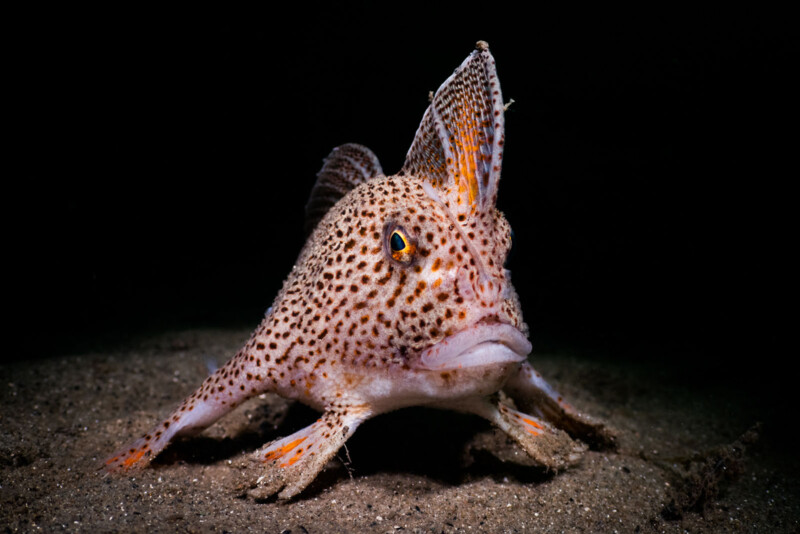Photographer Captures Rare Fish That Walks on its Hands

A photographer captured one of the rarest animals in the world — a fish that can walk on its hands.
It is believed there are less than 3,000 spotted handfish left in the wild, and the only place you can see them is in Tasmania, Australia which is where underwater photographer Nicolas Remy traveled to.
“I took these handfish photographs in July 2022, diving the Derwent River near Hobart (Tasmania),” Remy tells PetaPixel.
“I found most of the handfish on a relatively shallow site (less than 10 meters depth), where the water was 11 to 12 degrees Celsius in temperature, courtesy of the Tasmanian Winter.
“While depth wasn’t an issue, the water was very murky, with a visibility of about two meters, which would drop even lower if I had the unfortunate idea to touch the silty river floor.
“I spent a total of nine hours diving this place, diving for two to three hours at a time, and I have been fortunate to find up to seven handfish over one long dive.
“They are a challenge to spot though, as they lay still on the bottom, among bits of algae, shells, and sea stars.”
![]()
Handfish have hand-shaped pectoral fins which they use to walk on the seafloor. It is very different from most fish who can swim freely — the handfish is stuck to the seabed.
Sadly, the spotted handfish used to be common in the southern Australian state but the rare fish is being wiped out thanks to an introduced invasive species; the North Pacific seastar which feeds on the sponges where handfish would normally lay its eggs. It also faces challenges because of human activity.
“An aggravating factor is that handfish aren’t very resilient,” adds Remy. “Their young hatch and start living exactly where their parents bred, and being only able to walk, they won’t cover long distances.
“What that means is if a handfish population can easily get wiped out from a location, and won’t come back unless re-introduced.”
Photographing a Handfish
Remy, who is based in Sydney, Australia, was using a Nikon D810 enclosed within Nauticam underwater housing. The D810 had a 105mm macro lens attached but Remy brought something extra with him too.
“I also wanted to create some close-up images with a wide-angle feel, and for that, I used the Nauticam EMWL wet lens,” he says.
“It’s a bug-eye lens, similar concept to the Laowa probe lens, but optimized optically for use in the water.
“I am so glad I brought the EMWL over because I found the spotted handfish was a little skittish and would flee unless I was extra careful with my approach. They surely wouldn’t have tolerated a bulky fisheye lens and dome port up close, but the one-inch front optic of the EMWL was tiny enough for them.”
![]()
Lighting
Lighting underwater is difficult enough, but on a gloomy riverbed the situation is dire and although Remy brought with him a Retra Flash Pro strobe he still had to use a modifier to get the desired results.
“In murky waters, strobes tend to light up an awful lot of floating particles (backscatter), so I had to set up my lighting to cover the handfish while minimizing the amount of particles lit up,” he says.
“For this, I used Retra LSD snoots, which are essentially optical tubes, which I attached in front of the strobes to narrow down their light beams.
“Having such controllable lighting also made it possible to produce these rich black backgrounds during daytime.”
Passionate Underwater Photographer
“I think from the outside underwater photography is perceived as a niche, but we actually have many smaller niches in the liquid world!” Says Remy.
“Macro, super macro, wide-angle, close-focus wide-angle, portraits, behavior, wrecks, models…I find all these interesting, and shoot and teach all these genres of underwater photography.”
![]()
Remy has been shooting underwater since 2008 and in 2021 he decided to leave his corporate IT job to dedicate himself full-time to photography.
He launched The Underwater Club, an online underwater photography school with lots of tutorials.
“It’s also an online photo club, with private forums where we offer constructive photo critique and monthly get-together events,” says Remy.
“I also do private coaching and occasionally lead workshops, but my main focus is being available for our club members.”
Remy’s photo courses can be found here. His underwater photo work can be seen on his website, Instagram, and Facebook.
Image credits: All photos by Nicholas Remy.